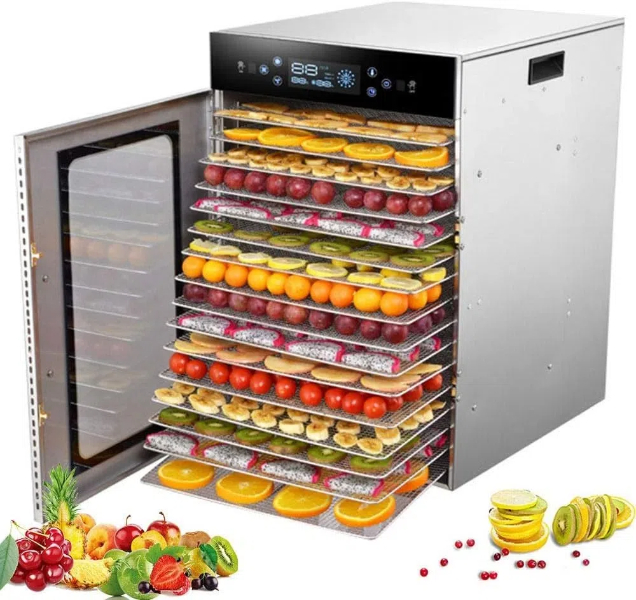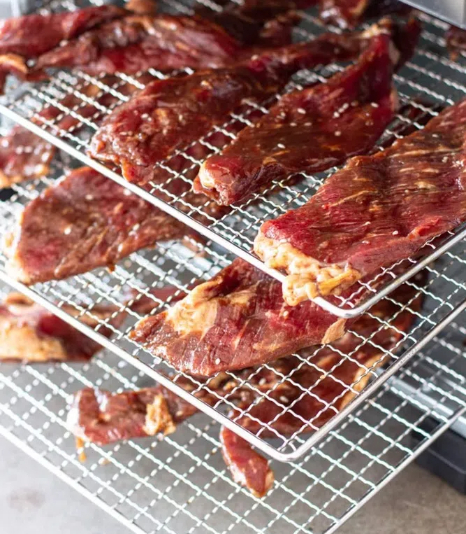
Content Menu
● Understanding Hang Type Dryers
● Key Components of Hang Type Dryers
● Importance of Regular Maintenance
● Maintenance Tips for Hang Type Dryers
>> 1. Daily Checks
>> 2. Weekly Maintenance
>> 3. Monthly Maintenance
>> 4. Annual Maintenance
● Troubleshooting Common Issues
>> 1. Uneven Drying
>> 2. Over-Drying
>> 3. Under-Drying
>> 4. Excessive Noise or Vibration
>> 5. Heating Element Failure
● Best Practices for Optimal Performance
● Conclusion
● FAQs
>> 1. How often should I clean my hang type dryer?
>> 2. What should I do if my dryer is not heating properly?
>> 3. How can I prevent uneven drying of food products?
>> 4. What records should I keep during the drying process for each batch?
>> 5. Can I perform all maintenance tasks myself, or should I hire a professional technician?
● Citations:
Maintaining a hang type dryer is essential for ensuring optimal performance, prolonging its lifespan, and guaranteeing the quality of dried food products. These dryers are widely used in the food processing industry for efficiently drying various types of food items, from fruits and vegetables to meats and herbs. Regular maintenance not only enhances operational efficiency but also safeguards the nutritional value and flavor of the dried products. This comprehensive guide provides in-depth maintenance tips, industry best practices, detailed troubleshooting advice, and proactive strategies to keep your hang type dryer in peak condition.

Understanding Hang Type Dryers
Hang type dryers employ a sophisticated system where food items are carefully hung within a specialized drying chamber, facilitating uniform circulation of warm air around each piece. This drying method is particularly effective for food items such as fruits, vegetables, herbs, and meats, as it preserves their inherent flavor profiles, nutritional content, and structural integrity. The design minimizes contact with surfaces, reducing the risk of sticking and damage.
Key Components of Hang Type Dryers
1. Drying Chamber: The central component where food items are suspended for drying. It's designed to optimize airflow and temperature distribution.
2. Heating Element: Responsible for generating the heat required for the drying process. It must be efficient and reliable to maintain consistent temperatures.
3. Air Circulation System: Ensures even and consistent distribution of warm air throughout the drying chamber, facilitating uniform drying.
4. Humidity Control System: Crucial for monitoring and precisely adjusting humidity levels within the drying chamber, preventing both over-drying and under-drying.
5. Control Panel: The nerve center of the dryer, allowing operators to set temperatures, humidity levels, drying times, and monitor the drying process in real-time.
Importance of Regular Maintenance
Regular maintenance of hang type dryers is not just a matter of convenience; it's a crucial factor impacting operational costs, product quality, and equipment longevity. Here's why:
1. Enhanced Efficiency: A well-maintained dryer operates with optimal efficiency, minimizing energy consumption and reducing operational costs.
2. Superior Product Quality: Proper maintenance ensures consistent and uniform drying, preserving the taste, texture, and nutritional value of the dried products. It prevents issues such as case hardening or uneven moisture content.
3. Extended Longevity: Regular checks, cleaning, and timely repairs significantly extend the lifespan of the equipment, protecting your investment.
4. Safety: A well-maintained dryer is safer to operate, reducing the risk of malfunctions, fires, and other hazards.

Maintenance Tips for Hang Type Dryers
1. Daily Checks
These quick daily checks can prevent small issues from escalating into major problems.
- Inspect the Heating Element: Visually inspect the heating element for any signs of damage, such as cracks, corrosion, or burnt spots. Ensure it’s functioning correctly without emitting unusual noises or odors.
- Check Air Filters: Regularly clean or replace air filters to maintain optimal airflow. Dirty filters restrict airflow, reducing efficiency and potentially overheating the system.
- Monitor Humidity Levels: Utilize digital controls to continuously monitor humidity levels within the drying chamber. Adjust settings as needed based on the type of food being dried.
- Check Hangers and Supports: Ensure that all hangers and support structures are in good condition and properly aligned. Replace any damaged or worn components.
2. Weekly Maintenance
Weekly maintenance tasks help maintain cleanliness and prevent buildup of residues.
- Clean the Drying Chamber: Thoroughly clean the drying chamber to remove any food residue, dust, or debris that may have accumulated during operation. Use food-safe cleaning agents and ensure the chamber is completely dry before the next use.
- Inspect Seals and Gaskets: Carefully inspect all seals and gaskets around doors, windows, and access panels. Replace any that show signs of wear, cracks, or damage to prevent air leaks, which can reduce efficiency.
- Test Airflow: Use an anemometer to measure airflow at various points within the drying chamber. Ensure that air is circulating freely and uniformly throughout the chamber. Address any blockages or obstructions.
- Lubricate Moving Parts: Lubricate any moving parts, such as fan bearings and conveyor chains, according to the manufacturer's recommendations. This reduces friction and prevents premature wear.
3. Monthly Maintenance
Monthly deep cleaning and calibration ensure consistent performance.
- Deep Clean Filters and Vents: Perform a deep cleaning of all filters and vents to remove accumulated dust, lint, and debris. Use a vacuum cleaner or compressed air to thoroughly clean hard-to-reach areas.
- Calibrate Sensors: Regularly calibrate temperature and humidity sensors using calibrated instruments to ensure accurate readings. Proper calibration is essential for maintaining consistent drying conditions.
- Inspect Electrical Connections: Check all electrical connections for tightness and corrosion. Loose or corroded connections can cause overheating, malfunctions, and safety hazards.
- Check Fan Blades: Inspect fan blades for damage, cracks, or imbalance. Replace any damaged blades and ensure that the fan is properly balanced to prevent vibrations and noise.
4. Annual Maintenance
Annual professional inspection can catch issues that are not easily visible.
- Professional Inspection: Schedule a comprehensive inspection by a qualified technician. The technician should inspect all major components, including the heating element, air circulation system, humidity control system, and electrical systems.
- Replace Worn Parts: Based on the technician's inspection, identify and replace any parts that show signs of wear, damage, or degradation. This proactive approach can prevent costly breakdowns and extend the lifespan of the dryer.
- Review Safety Procedures: Review safety procedures with all operators to ensure they are familiar with the proper operation, maintenance, and emergency procedures for the dryer.
- Update Documentation: Update all documentation, including maintenance logs, operating manuals, and safety procedures, to reflect any changes or updates made during the year.
Troubleshooting Common Issues
1. Uneven Drying
- Cause: Inadequate spacing between items, overloading the dryer, uneven airflow, or malfunctioning heating elements.
- Solution: Ensure that food items are spaced adequately apart to allow for proper airflow. Avoid overloading the dryer, as this can block airflow. Check and adjust the position of heating elements to ensure uniform heating.
2. Over-Drying
- Cause: Incorrect temperature settings, prolonged drying times, or inaccurate humidity control.
- Solution: Regularly calibrate temperature settings based on product requirements. Closely monitor drying times to avoid excessive drying. Ensure the humidity control system is functioning correctly and maintaining appropriate humidity levels.
3. Under-Drying
- Cause: Insufficient temperature, inadequate drying time, or excessive humidity.
- Solution: Increase temperature settings if products are not drying adequately. Extend the drying time as needed. Ensure that humidity levels are being properly controlled and are within the recommended range.
4. Excessive Noise or Vibration
- Cause: Loose or damaged fan blades, unbalanced fan, or worn bearings.
- Solution: Inspect fan blades for damage and replace as needed. Balance the fan to prevent vibrations. Lubricate or replace worn bearings.
5. Heating Element Failure
- Cause: Overheating, corrosion, or electrical faults.
- Solution: Inspect the heating element for signs of damage. Check electrical connections for tightness and corrosion. Replace the heating element if necessary.
Best Practices for Optimal Performance
1. Proper Loading: Prepare food items by washing, cutting into uniform sizes, and blanching when necessary before loading them into the dryer. Uniform preparation ensures consistent drying.
2. Accurate Record Keeping: Maintain detailed records of each batch processed, including initial moisture content, drying time, temperature settings, and final product quality. This data helps optimize future drying processes and troubleshoot any issues.
3. Utilize Digital Controls: Maximize the use of digital controls for continuous monitoring of temperature and humidity levels throughout the drying process. Set alarms for critical parameters to alert operators of any deviations.
4. Training: Provide thorough training to all operators on the proper operation, maintenance, and safety procedures for the dryer. Ensure they understand the importance of regular maintenance and are capable of performing basic troubleshooting.
Conclusion
Consistent and meticulous maintenance of hang type dryers is paramount for achieving optimal performance in food processing applications. By adhering to these comprehensive maintenance tips, incorporating best practices, and promptly addressing any issues, operators can significantly enhance efficiency, minimize energy consumption, and ensure the consistent production of high-quality dried food products. This proactive approach not only extends the lifespan of the equipment but also safeguards the profitability and sustainability of your food processing operations.

FAQs
1. How often should I clean my hang type dryer?
It is recommended to perform a quick daily cleaning of the drying chamber and filters to remove any loose debris. A more thorough cleaning should be done weekly, and a deep cleaning with sanitization should be scheduled monthly.
2. What should I do if my dryer is not heating properly?
First, check the heating element for any visible damage, such as cracks or breaks. Ensure that all electrical connections are secure and that the power supply is adequate. If the issue persists, consult a qualified technician to diagnose and repair the heating system.
3. How can I prevent uneven drying of food products?
To prevent uneven drying, ensure that food items are uniformly sized and spaced adequately apart to allow for consistent airflow around each piece. Avoid overloading the dryer, as this can restrict airflow. Also, verify that the heating elements are functioning correctly and that the air circulation system is operating at the correct speed and direction.
4. What records should I keep during the drying process for each batch?
Maintain detailed records for each batch, including the date, type of food being dried, initial moisture content, drying time, temperature settings, humidity levels, and final product quality. This data helps in optimizing the drying process and troubleshooting any issues that may arise.
5. Can I perform all maintenance tasks myself, or should I hire a professional technician?
While many routine maintenance tasks, such as cleaning and filter replacement, can be performed by trained operators, it is recommended to schedule a professional inspection and maintenance service at least annually. A qualified technician can identify and address potential issues that may not be apparent during routine checks.
Citations:
[1] https://www.dryeratech.com/how-to-optimize-your-hang-type-drying-process.html
[2] https://patents.google.com/patent/WO2017197612A1/zh
[3] https://www.whirlpool.com/blog/washers-and-dryers/washer-dryer-maintenance.html
[4] https://patents.google.com/patent/WO2014008874A1/zh
[5] https://www.coastappliances.ca/blogs/learn/dryer-cleaning-and-maintenance
[6] https://patents.google.com/patent/CN100557113C/zh
[7] https://www.intelligenthanddryers.com/blogs/news/hand-dryer-maintenance-101
[8] https://patents.google.com/patent/CN1405396A/zh











